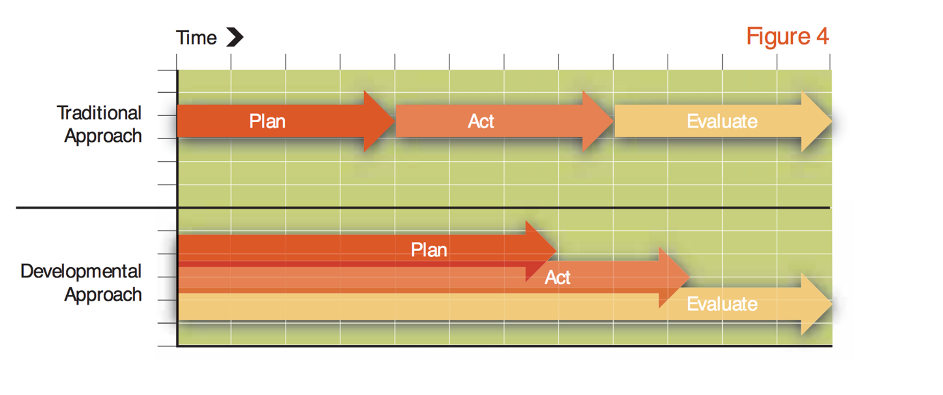Core Capacities Overview: Cycles of Reflection
Learn Through Continuous Cycles of Reflection that Include Seeing, Sense-Making, and Acting
Across disciplines, resilience is often understood as an ongoing process rather than a static place at which a system arrives (Ungar, 2018). An integral dimension of this process is the ability to reflect on actions, identify relevant insights and apply those insights, as appropriate and relevant, to the work ahead. Tyler and Moench (2012) include “Capacity to learn” as a critical ability among agents within resilient systems. They define this capacity as the “ability to internalize past experiences, avoid repeated failures and innovate to improve performance” (Tyler & Moench, 2012, p. 316). Literature on competencies for public sector innovation, an umbrella within which climate adaptation planning can be included, incorporate similar qualities which are often described as accelerated or iterative learning (Nesta, 2019). Standard adaptation planning frameworks typically include recommendations to evaluate and update plans based on what is being learned at different stages in the process (ICLEI Canada, 2019).
While this may all seem obvious, it is worth noting that intentional practices of iterative learning cycles, which inform subsequent action in meaningful ways, can feel and look different than standard project management or even strategic planning processes. The kind of cyclical reflective learning proposed in this course more closely aligns with assumptions and practices found in the field of developmental evaluation, a process which “facilitates assessments of where things are and reveals how things are unfolding; helps to discern which directions hold promise and which ought to be abandoned; and suggests what new experiments should be tried” (Gamble, 2008, p. 18). The primary reason for this distinction comes from the assumption that dialogue and engagement are inherently complex, as is the process of climate adaptation planning, and both can benefit from methods that are intentionally designed to find wise action with the unpredictable and dynamic nature of these contexts. This is different from evaluating outcomes based on achievement of predetermined goals once a planning process has been completed, or only at pre-determined points along the way. In the graphic below, Gamble (2008) demonstrates the difference between these approaches.
Figure 4. from Gamble, J. A. A. (2008). A Developmental Evaluation Primer. McConnell Foundation. from https://mcconnellfoundation.ca/wp-content/uploads/2017/07/A-Developmental-Evaluation-Primer-EN.pdf , page 31 is under copyright of the McConnell Foundation.
According to Senge, Hamilton and Kania (2015), “progressive cycles of action and reflection and learning over time,” particularly when these cycles involve multiple parties or participants from within the system, enable us to “search for higher leverage changes” (p. 30). They are careful to point out, however, that this is not a call to eliminate plans all together. “Plans are, of course, always needed, but without openness people can miss what is emerging, like a sailor so committed to [their] initial course that [they] won’t adjust to shifts in the wind” (Senge et al., 2015, p. 30).
Engaging in this kind of reflection and action process incorporates and also benefits from the skills described above. Specific methods for this approach exist in many fields, including developmental evaluation, public sector innovation and Human Systems Dynamics (HSD). HSD has a particularly helpful set of questions, which complements the developmental evaluation approach, in what they call the Adaptive Action cycle of What, So What and Now What (Human Systems Dynamics Institute, 2016). Elaborated on, this process might look like asking (at the end of a meeting, at a key decision point in a project, following the end of a granting cycle or at any other natural inflection point) questions such as: What happened? What surprised us? What do we notice? So, what is important? So, what stands out? So, what do we need to pay attention to? So, what are we learning? Now what will we do differently? Now what action is called for? (Note: This is a sample and many other kinds of questions can also be useful, following this cycle).


